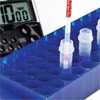Preventing Deaths from Cryptococcal Meningitis
At-a-glance factsheet
What is cryptococcal meningitis?
Cryptococcus neoformans is a fungus that lives in the environment throughout the world. Most people likely breathe in this microscopic fungus when they are children but never get sick from it, but in people with weakened immune systems such as those living with HIV/AIDS, Cryptococcus can stay hidden in the body and later become a serious (but not contagious) brain infection called cryptococcal meningitis.
Why is cryptococcal meningitis a problem?
Most cases of cryptococcal meningitis occur in people who have HIV/AIDS. The widespread availability of antiretroviral therapy (ART) in developed countries has helped improve the immune systems of many HIV patients so that they don’t become vulnerable to infection with Cryptococcus. However, cryptococcal meningitis is still a major problem in resource-limited countries where HIV prevalence is high and access to healthcare is limited. Worldwide, nearly 220,000 new cases of cryptococcal meningitis occur each year, resulting in 181,000 deaths. Most of the illnesses and deaths occur in sub-Saharan Africa.
Strategies to prevent deaths

CDC is working with several countries on strategies to prevent deaths due to cryptococcal meningitis.
Although it’s not possible to prevent the initial exposure to Cryptococcus, diagnosing and treating early cryptococcal infections in people at high risk for developing cryptococcal meningitis can prevent associated deaths. Therefore, CDC is working to improve diagnosis and treatment of cryptococcal meningitis in countries with large populations of people living with HIV/AIDS. In these areas, CDC is helping implement targeted cryptococcal screening programs and build laboratory capacity to detect cryptococcal infections early. This allows for more timely treatment, reduced mortality due to cryptococcal meningitis, and overall improved quality of life.
- Targeted screening for early cryptococcal infection
Cryptococcal antigen, a chemical marker for cryptococcal infection, can be detected in the body weeks to months before symptoms of meningitis appear. In a targeted screening program, people who have advanced HIV infection are tested for cryptococcal antigen before starting ART. A patient who tests positive for cryptococcal antigen can take antifungal medication to help the body fight the early stage of the infection, which has been shown to prevent deaths due to cryptococcal meningitis. - Improved access to diagnostics

In order to screen people living with HIV for early cryptococcal infection and to diagnose other patients with cryptococcal meningitis, healthcare facilities and laboratories must have access to the right diagnostic tests. Currently, these tests are unavailable in many district and provincial laboratories in sub-Saharan Africa. Equipping these facilities with the ability to perform these tests is an important step in reducing deaths from cryptococcal meningitis.
A new lateral flow assay for detecting cryptococcal antigen is simple to use on a small sample of blood or spinal fluid. The test accurately detects both early and advanced cryptococcal infections more than 95% of the time. In addition, the test is inexpensive, rapid, and doesn’t require costly laboratory equipment and expertise, making it ideal for resource-limited settings. - Improved access to antifungal medications

Essential medications for the treatment of cryptococcal infections are often unavailable in areas of the world that are most in need. Amphotericin B and flucytosine are two antifungal medications that have been shown to improve survival in patients with cryptococcal meningitis. Although these drugs are the standard-of-care in developed countries, they are widely unavailable in sub-Saharan Africa and Asia.
Preventing deaths from cryptococcal meningitis: resources for countries
CDC’s training materials can be used to educate physicians, nurses, HIV/AIDS counselors, pharmacists, and patients about the diagnosis, management, and prevention of cryptococcal disease. These materials are intended to help healthcare providers, particularly those in resource-limited settings, implement a screen-and-treat strategy for cryptococcal disease among people living with HIV/AIDS. CDC can help provide customized resources on training and case studies for cryptococcal screening. Please email cryptococcus@cdc.gov for more information.
Related Links
- CDC – C. neoformans cryptococcosis
- CDC – Global HIV/AIDS
-
WHO: World Health Organization – Cryptococcal Infection
The World Health Organization has developed guidelines for the diagnosis, prevention, and management of cryptococcal disease in HIV-infected adults, adolescents, and children. These guidelines are the first to recommend cryptococcal screening in certain settings to prevent deaths due to cryptococcal meningitis. -
PreventCrypto.org
Preventcrypto.org is an international collaboration between government and non-governmental organizations, academic institutions, and private industry partners. The group consists of public health professionals, healthcare providers, academic researchers, and laboratorians who are dedicated to reducing the global burden of cryptococcal disease. -
LIFE: Leading International Fungal Education
LIFE is an international non-governmental organization that aims to fight fungal infections by facilitating access to quality diagnostics, patient care, and educational resources around the globe. - World Health Organization – Guidelines for managing advanced HIV disease and rapid initiation of antiretroviral therapy
- Page last reviewed: September 30, 2014
- Page last updated: July 20, 2017
- Content source:


 ShareCompartir
ShareCompartir